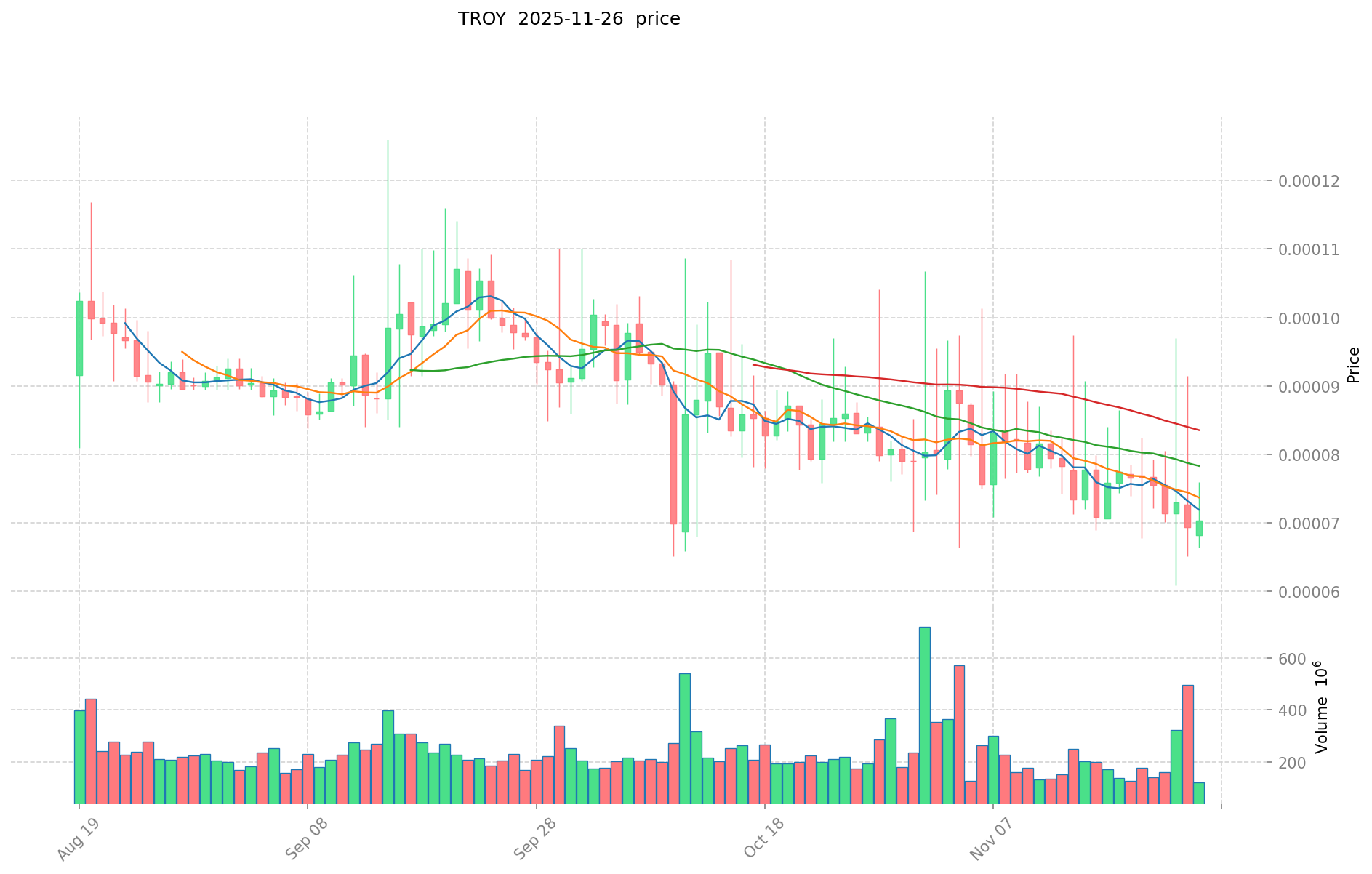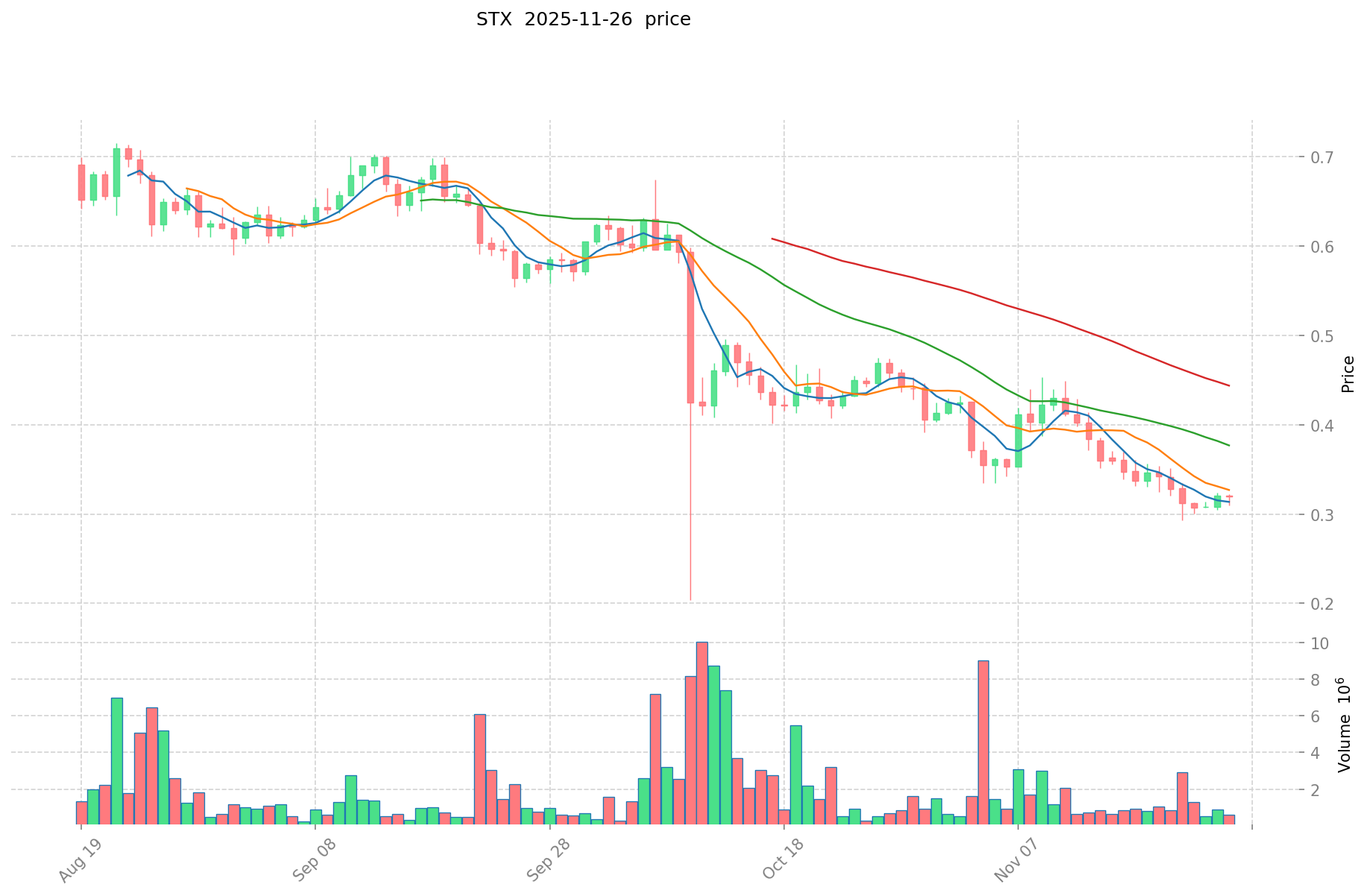TROY vs STX: The Battle of Blockchain Ecosystems in the DeFi Space
Introduction: TROY vs STX Investment Comparison
In the cryptocurrency market, the comparison between TROY and STX has always been a topic investors can't avoid. The two not only show significant differences in market cap ranking, application scenarios, and price performance, but also represent different positioning in the crypto asset space.
TROY (TROY): Since its launch in 2019, it has gained market recognition for its focus on crypto trading and asset management services.
Stacks (STX): Introduced in 2019, it has been hailed as a new decentralized internet platform, being one of the top cryptocurrencies in global trading volume and market capitalization.
This article will comprehensively analyze the investment value comparison between TROY and STX, focusing on historical price trends, supply mechanisms, institutional adoption, technological ecosystems, and future predictions, attempting to answer the question investors care most about:
"Which is the better buy right now?"
I. Price History Comparison and Current Market Status
TROY (Coin A) and STX (Coin B) Historical Price Trends
- 2025: TROY experienced a significant price decline, reaching its all-time low of $0.00006288 on November 24, 2025.
- 2024: STX reached its all-time high of $3.86 on April 1, 2024, marking a significant milestone for the project.
- Comparative Analysis: In the recent market cycle, TROY has fallen from its all-time high of $0.03652384 to its current price of $0.00007226, while STX has declined from its peak of $3.86 to $0.3188.
Current Market Situation (2025-11-26)
- TROY current price: $0.00007226
- STX current price: $0.3188
- 24-hour trading volume: TROY $11,763.90 vs STX $178,469.38
- Market Sentiment Index (Fear & Greed Index): 20 (Extreme Fear)
Click to view real-time prices:
- View TROY current price Market Price
- View STX current price Market Price


II. Core Factors Affecting the Investment Value of TROY vs STX
Supply Mechanism Comparison (Tokenomics)
- TROY: Limited supply of 10 billion tokens with a deflationary model through token burns
- STX: Capped supply with a halving mechanism similar to Bitcoin, reducing block rewards over time
- 📌 Historical pattern: Deflationary mechanisms tend to support price appreciation during bull markets, while halving events typically create cyclical price movements.
Institutional Adoption and Market Applications
- Institutional holdings: STX has gained more institutional traction due to its Bitcoin connection and clearer regulatory status
- Enterprise adoption: STX is being integrated into Bitcoin-related financial products and services, while TROY's trading infrastructure sees limited enterprise implementation
- National policies: Regulatory clarity favors STX in North America, while TROY faces more regulatory uncertainty in various jurisdictions
Technical Development and Ecosystem Building
- TROY technical upgrades: Development of decentralized trading infrastructure and broker systems with limited recent advancements
- STX technical development: Continued improvement of Clarity smart contracts and Bitcoin L2 functionality, strengthening its position in the Bitcoin ecosystem
- Ecosystem comparison: STX has a stronger ecosystem focused on Bitcoin DeFi applications, NFTs (Ordinals), and smart contract functionality, while TROY's ecosystem remains focused primarily on trading infrastructure
Macroeconomic Environment and Market Cycles
- Performance during inflation: STX demonstrates stronger correlation with Bitcoin, potentially offering better inflation hedge properties
- Macroeconomic monetary policy: Interest rate changes affect STX more directly due to its connection to Bitcoin's market dynamics
- Geopolitical factors: STX benefits from increased Bitcoin adoption in uncertain geopolitical environments, while TROY lacks this direct association
III. 2025-2030 Price Prediction: TROY vs STX
Short-term Prediction (2025)
- TROY: Conservative $0.0000674157 - $0.00007249 | Optimistic $0.00007249 - $0.000086988
- STX: Conservative $0.20416 - $0.319 | Optimistic $0.319 - $0.43065
Mid-term Prediction (2027)
- TROY may enter a growth phase, expected price range $0.00008338705925 - $0.000123675189
- STX may enter a bullish market, expected price range $0.3896305875 - $0.60176279625
- Key drivers: Institutional capital inflow, ETF, ecosystem development
Long-term Prediction (2030)
- TROY: Base scenario $0.00011520531242 - $0.00013191008272 | Optimistic scenario $0.00013191008272 - $0.000171483107537
- STX: Base scenario $0.556143548296875 - $0.659030104731796 | Optimistic scenario $0.659030104731796 - $0.968774253955741
Disclaimer: The above predictions are based on historical data and market analysis. Cryptocurrency markets are highly volatile and subject to change. This information should not be considered as financial advice. Always conduct your own research before making investment decisions.
TROY:
| 年份 | 预测最高价 | 预测平均价格 | 预测最低价 | 涨跌幅 |
|---|---|---|---|---|
| 2025 | 0.000086988 | 0.00007249 | 0.0000674157 | 0 |
| 2026 | 0.00010764765 | 0.000079739 | 0.00004465384 | 10 |
| 2027 | 0.000123675189 | 0.000093693325 | 0.00008338705925 | 29 |
| 2028 | 0.00012172636784 | 0.000108684257 | 0.00005868949878 | 50 |
| 2029 | 0.000148614853021 | 0.00011520531242 | 0.000096772462432 | 59 |
| 2030 | 0.000171483107537 | 0.00013191008272 | 0.000069912343842 | 82 |
STX:
| 年份 | 预测最高价 | 预测平均价格 | 预测最低价 | 涨跌幅 |
|---|---|---|---|---|
| 2025 | 0.43065 | 0.319 | 0.20416 | 0 |
| 2026 | 0.49102075 | 0.374825 | 0.269874 | 17 |
| 2027 | 0.60176279625 | 0.432922875 | 0.3896305875 | 35 |
| 2028 | 0.59494426096875 | 0.517342835625 | 0.39835398343125 | 61 |
| 2029 | 0.761916661166718 | 0.556143548296875 | 0.361493306392968 | 74 |
| 2030 | 0.968774253955741 | 0.659030104731796 | 0.408598664933714 | 106 |
IV. Investment Strategy Comparison: TROY vs STX
Long-term vs Short-term Investment Strategies
- TROY: Suitable for investors focused on trading infrastructure and potential ecosystem growth
- STX: Suitable for investors seeking Bitcoin ecosystem exposure and smart contract functionality
Risk Management and Asset Allocation
- Conservative investors: TROY: 20% vs STX: 80%
- Aggressive investors: TROY: 40% vs STX: 60%
- Hedging tools: Stablecoin allocation, options, cross-currency portfolio
V. Potential Risk Comparison
Market Risk
- TROY: High volatility and low liquidity
- STX: Correlation with Bitcoin market movements
Technical Risk
- TROY: Scalability, network stability
- STX: Smart contract vulnerabilities, Bitcoin network dependencies
Regulatory Risk
- Global regulatory policies may impact both differently, with STX potentially facing less scrutiny due to its Bitcoin association
VI. Conclusion: Which Is the Better Buy?
📌 Investment Value Summary:
- TROY advantages: Focus on trading infrastructure, potential for growth in decentralized trading
- STX advantages: Strong Bitcoin ecosystem connection, smart contract functionality, institutional interest
✅ Investment Advice:
- Novice investors: Consider a higher allocation to STX due to its stronger ecosystem and Bitcoin connection
- Experienced investors: Balanced approach with a slight bias towards STX, monitor TROY for potential trading infrastructure developments
- Institutional investors: Focus on STX for its regulatory clarity and Bitcoin ecosystem integration
⚠️ Risk Warning: The cryptocurrency market is highly volatile. This article does not constitute investment advice. None
VII. FAQ
Q1: What are the main differences between TROY and STX? A: TROY focuses on crypto trading and asset management services, while STX is positioned as a decentralized internet platform with strong ties to the Bitcoin ecosystem. STX has a larger market cap, higher trading volume, and more institutional adoption compared to TROY.
Q2: Which coin has performed better historically? A: STX has shown better historical performance. It reached an all-time high of $3.86 in April 2024, while TROY experienced a significant price decline, reaching its all-time low of $0.00006288 in November 2025.
Q3: How do the supply mechanisms of TROY and STX differ? A: TROY has a limited supply of 10 billion tokens with a deflationary model through token burns. STX has a capped supply with a halving mechanism similar to Bitcoin, reducing block rewards over time.
Q4: Which coin has better institutional adoption? A: STX has gained more institutional traction due to its Bitcoin connection and clearer regulatory status. It is being integrated into Bitcoin-related financial products and services, while TROY's trading infrastructure sees limited enterprise implementation.
Q5: What are the key factors affecting the future price of these coins? A: Key factors include institutional capital inflow, potential ETF approvals, ecosystem development, regulatory changes, and overall market sentiment. STX's price is also influenced by Bitcoin's market dynamics.
Q6: What are the recommended investment strategies for TROY and STX? A: For conservative investors, a suggested allocation is 20% TROY and 80% STX. For aggressive investors, the recommendation is 40% TROY and 60% STX. STX is generally considered more suitable for long-term investment due to its stronger ecosystem and Bitcoin connection.
Q7: What are the main risks associated with investing in TROY and STX? A: TROY faces high volatility, low liquidity, and potential scalability issues. STX risks include correlation with Bitcoin market movements and smart contract vulnerabilities. Both coins are subject to regulatory risks, although STX may face less scrutiny due to its Bitcoin association.
Share
Content